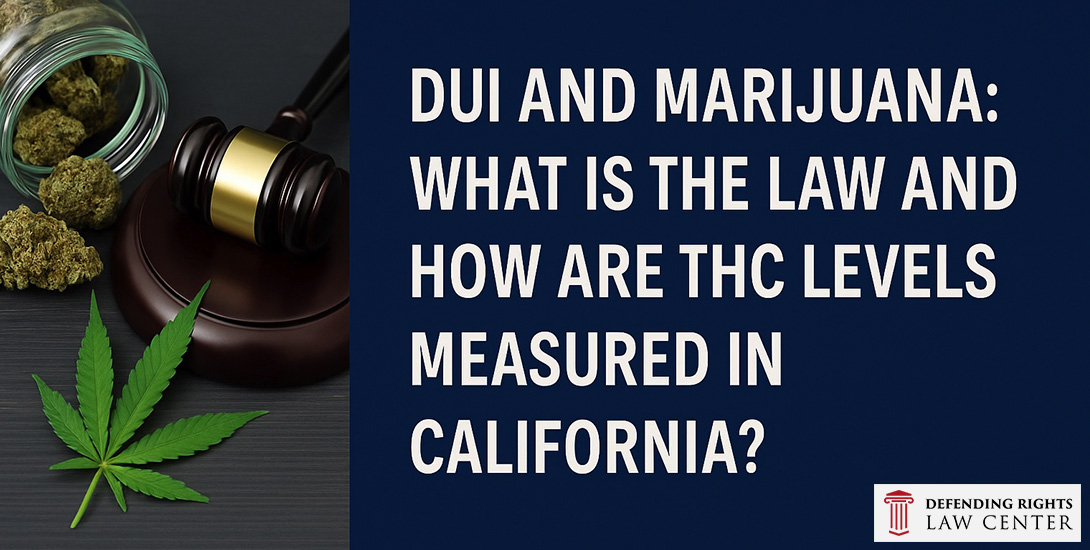
California has long been at the forefront of cannabis legalization, but with legalization comes stricter enforcement of laws against impaired driving. Many people are surprised to learn that you can be arrested for driving under the influence of marijuana (DUI of cannabis) even if you are a legal, recreational user. Unlike alcohol, where the law sets a clear limit for impairment, marijuana DUI enforcement involves complicated testing, subjective observations, and scientific debate about what constitutes impairment.
In this article, we explain what the law says, how marijuana DUIs are investigated, and why measuring THC levels is so challenging in California.
What the Law Says About Marijuana and DUI in California
California Vehicle Code § 23152(f) makes it unlawful to drive under the influence of any drug, including marijuana. The law does not set a “legal limit” for marijuana the way it does for alcohol (0.08% BAC). Instead, prosecutors must prove that:
- You consumed marijuana; and
- As a result, your mental or physical abilities were so impaired that you could no longer drive with the caution of a sober person, using ordinary care, under similar circumstances.
Impairment is based on performance and observation—not just numbers on a test. It is not possible to determine marijuana impairment by chemical test results alone.
How Police Investigate Suspected Marijuana DUIs
- Initial Observations — Odor of cannabis, red or watery eyes, slowed speech, or marijuana paraphernalia in the vehicle.
- Field Sobriety Tests (FSTs) — Coordination tests (walk-and-turn, one-leg stand) designed for alcohol and less reliable for cannabis impairment.
- Drug Recognition Expert (DRE) Evaluation — A 12-step protocol performed by specially trained officers; see the California Highway Patrol DRE program.
- Chemical Testing — Typically a blood draw to measure THC and metabolites.
How THC Levels Are Measured
- No “per se” limit in California. Some states set numeric thresholds (e.g., 5 ng/mL THC in blood), but California has no statutory cutoff. See the NHTSA report on marijuana-impaired driving.
- Blood Tests. Most common method. THC is fat-soluble and can remain detectable long after acute effects subside.
- Urine Tests. Rarely used for DUI impairment because they show prior use, not present impairment.
- Emerging Tools. Breath and oral-fluid tests are being explored (see CHP’s Oral Fluid Pilot Program) but are not widely accepted in California courts.
Why Measuring THC Is Controversial
THC affects individuals differently. A casual user may be impaired at a low concentration, while a frequent user may show higher THC with little observable impairment. Because of this variability, prosecutors often rely heavily on officer testimony, driving patterns, and physical symptoms—sometimes more than numeric test results.
Common defense strategies include challenging the accuracy of blood testing and its handling, highlighting the absence of a reliable impairment threshold, and scrutinizing officer training and procedures.
Penalties for Marijuana DUI
- Fines and court assessments
- Mandatory DUI education programs
- License consequences (see the California DMV’s overview of DUI offenses)
- Possible jail time for repeat offenses or cases involving injury
Even a first offense can have lasting effects on your record and driving privileges.
Final Thoughts
While marijuana is legal in California, driving under its influence is not. The science of measuring cannabis impairment is evolving, which means there may be opportunities to challenge the evidence in a marijuana DUI case—whether by disputing test reliability, contesting observations, or identifying procedural errors.
If you’re facing a marijuana DUI, consult an experienced DUI defense attorney who understands both the law and the science.
Written by Joshua Price, published by Defending Rights Law Center®.
Monthly Archives
- November 2025
- September 2025
- October 2023
- July 2023
- June 2023
- May 2023
- March 2023
- October 2021
- February 2018
- December 2017
- August 2017
- June 2017
- April 2017
- March 2017
- January 2017
- November 2016
- October 2015
- September 2015
- August 2015
- July 2015
- June 2015
- May 2015
- April 2015
- March 2015
- February 2015
- January 2015
- December 2014
- November 2014
- October 2014
- September 2014
- August 2014

